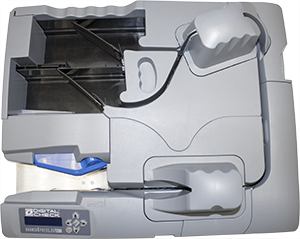| If you’ve seen our BranchXpress BX7200 scanner, you know it’s a BIG machine, and there’s a reason for that: Its size actually helps it scan and sort faster. As you know, the BranchXpress scans at 200 documents per minute (DPM) and features dual exit pockets. But what does size have to do with that?
Aren’t there smaller scanners out there with real-time sorting? Yes, but it depends on what you mean by “smaller” and what you consider “real-time.” With a shorter track length, you could still perform a sorting function, but in order to do that, you’d have to slow the documents down to allow time for each decision to be made and communicated. Many scanners with sorting functions operate this way, with the advertised speed achievable in a simple scan, but with a much lower DPM rate if sorting is turned on. So, long story short, to maintain the same speed with and without sorting, you need to lengthen the track. It is possible to increase the track length in a scanner while conserving a bit more physical space; typically, this is done by adding a W-curve to the document path. After testing various prototypes, we concluded that a straight U-shaped track with only two curves was the more reliable and durable choice for high-volume environments. The result was a slightly larger machine, but one whose capabilities more than make up for its bigger size. |
 The reason isn’t the higher speed, but rather the sorting function with two exit pockets. Look at the BX7200 from overhead, and you’ll notice that it has a much longer track length than other scanners – almost 18 inches longer than the models in our TellerScan series, to be exact. The extra distance doesn’t matter for pure scanning speed, but it adds an extra 300 milliseconds of transport time between the image sensor and the exit pocket. That’s important for real-time sorting: In that third of a second, a check image can be transmitted to the processing software, analyzed, and the physical document diverted into either exit pocket based on predetermined parameters.
The reason isn’t the higher speed, but rather the sorting function with two exit pockets. Look at the BX7200 from overhead, and you’ll notice that it has a much longer track length than other scanners – almost 18 inches longer than the models in our TellerScan series, to be exact. The extra distance doesn’t matter for pure scanning speed, but it adds an extra 300 milliseconds of transport time between the image sensor and the exit pocket. That’s important for real-time sorting: In that third of a second, a check image can be transmitted to the processing software, analyzed, and the physical document diverted into either exit pocket based on predetermined parameters.




